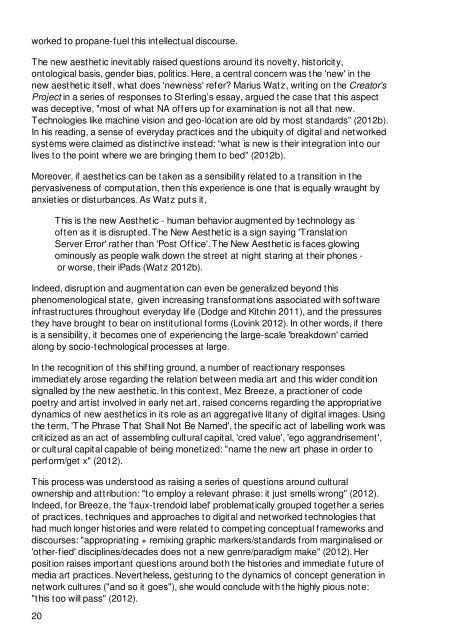New Aesthetic New Anxieties - Institute for the Unstable Media
New Aesthetic New Anxieties - Institute for the Unstable Media
New Aesthetic New Anxieties - Institute for the Unstable Media
Create successful ePaper yourself
Turn your PDF publications into a flip-book with our unique Google optimized e-Paper software.
worked to propane-fuel this intellectual discourse.The new aes<strong>the</strong>tic inevitably raised questions around its novelty, historicity,ontological basis, gender bias, politics. Here, a central concern was <strong>the</strong> 'new' in <strong>the</strong>new aes<strong>the</strong>tic itself, what does 'newness' refer? Marius Watz, writing on <strong>the</strong> Creator'sProject in a series of responses to Sterling’s essay, argued <strong>the</strong> case that this aspectwas deceptive, "most of what NA offers up <strong>for</strong> examination is not all that new.Technologies like machine vision and geo-location are old by most standards” (2012b).In his reading, a sense of everyday practices and <strong>the</strong> ubiquity of digital and networkedsystems were claimed as distinctive instead: “what is new is <strong>the</strong>ir integration into ourlives to <strong>the</strong> point where we are bringing <strong>the</strong>m to bed” (2012b).Moreover, if aes<strong>the</strong>tics can be taken as a sensibility related to a transition in <strong>the</strong>pervasiveness of computation, <strong>the</strong>n this experience is one that is equally wraught byanxieties or disturbances. As Watz puts it,This is <strong>the</strong> new <strong>Aes<strong>the</strong>tic</strong> - human behavior augmented by technology asoften as it is disrupted. The <strong>New</strong> <strong>Aes<strong>the</strong>tic</strong> is a sign saying 'TranslationServer Error' ra<strong>the</strong>r than 'Post Office'. The <strong>New</strong> <strong>Aes<strong>the</strong>tic</strong> is faces glowingominously as people walk down <strong>the</strong> street at night staring at <strong>the</strong>ir phones -or worse, <strong>the</strong>ir iPads (Watz 2012b).Indeed, disruption and augmentation can even be generalized beyond thisphenomenological state, given increasing trans<strong>for</strong>mations associated with softwareinfrastructures throughout everyday life (Dodge and Kitchin 2011), and <strong>the</strong> pressures<strong>the</strong>y have brought to bear on institutional <strong>for</strong>ms (Lovink 2012). In o<strong>the</strong>r words, if <strong>the</strong>reis a sensibility, it becomes one of experiencing <strong>the</strong> large-scale 'breakdown' carriedalong by socio-technological processes at large.In <strong>the</strong> recognition of this shifting ground, a number of reactionary responsesimmediately arose regarding <strong>the</strong> relation between media art and this wider conditionsignalled by <strong>the</strong> new aes<strong>the</strong>tic. In this context, Mez Breeze, a practioner of codepoetry and artist involved in early net.art, raised concerns regarding <strong>the</strong> appropriativedynamics of new aes<strong>the</strong>tics in its role as an aggregative litany of digital images. Using<strong>the</strong> term, 'The Phrase That Shall Not Be Named', <strong>the</strong> specific act of labelling work wascriticized as an act of assembling cultural capital, 'cred value', 'ego aggrandrisement',or cultural capital capable of being monetized: "name <strong>the</strong> new art phase in order toper<strong>for</strong>m/get x" (2012).This process was understood as raising a series of questions around culturalownership and attribution: "to employ a relevant phrase: it just smells wrong" (2012).Indeed, <strong>for</strong> Breeze, <strong>the</strong> 'faux-trendoid label' problematically grouped toge<strong>the</strong>r a seriesof practices, techniques and approaches to digital and networked technologies thathad much longer histories and were related to competing conceptual frameworks anddiscourses: "appropriating + remixing graphic markers/standards from marginalised or'o<strong>the</strong>r-fied' disciplines/decades does not a new genre/paradigm make" (2012). Herposition raises important questions around both <strong>the</strong> histories and immediate future ofmedia art practices. Never<strong>the</strong>less, gesturing to <strong>the</strong> dynamics of concept generation innetwork cultures ("and so it goes"), she would conclude with <strong>the</strong> highly pious note:"this too will pass" (2012).20








